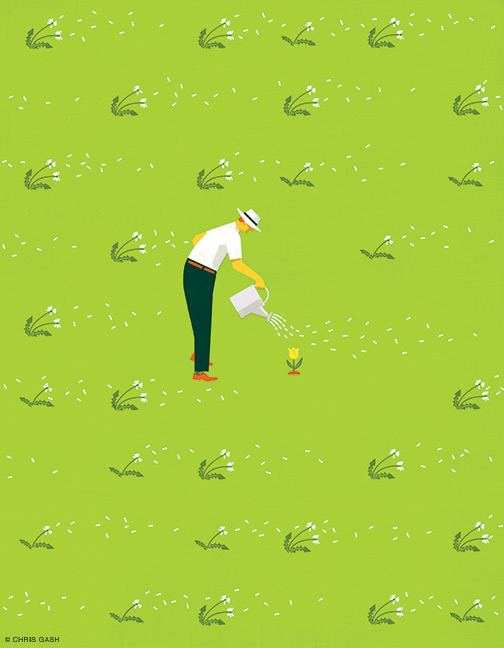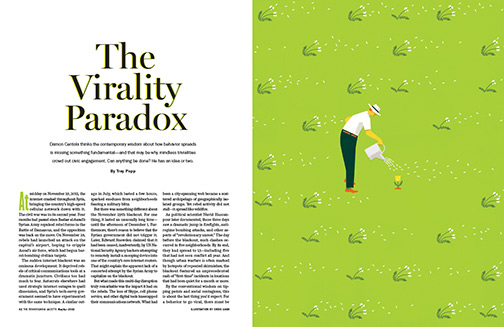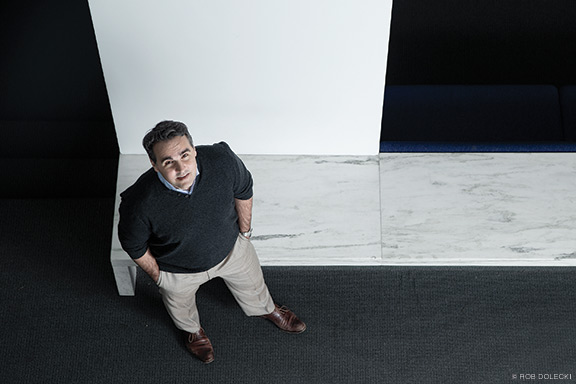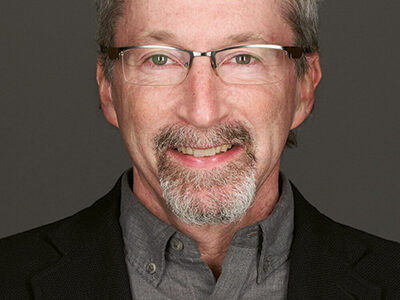
Damon Centola thinks the contemporary wisdom about how behavior spreads is missing something fundamental—and that may be why mindless trivialities crowd out civic engagement. Can anything be done? He has an idea or two.
BY TREY POPP | Illustration by Chris Gash

At midday on November 29, 2012, the internet crashed throughout Syria, bringing the country’s high-speed cellular network down with it. The civil war was in its second year. Four months had passed since Bashar al-Assad’s Syrian Army repulsed rebel forces in the Battle of Damascus, and the opposition was back on the move. On November 28, rebels had launched an attack on the capital’s airport, hoping to cripple Assad’s air force, which had begun barrel-bombing civilian targets.
The sudden internet blackout was an ominous development. It deprived rebels of critical communications tools at a dramatic juncture. Civilians too had much to fear. Autocrats elsewhere had used strategic internet outages to quell dissension, and Syria’s tech-savvy government seemed to have experimented with the same technique. A similar outage in July, which lasted a few hours, sparked exoduses from neighborhoods fearing a military blitz.
But there was something different about the November 29th blackout. For one thing, it lasted an unusually long time—until the afternoon of December 1. Furthermore, there’s reason to believe that the Syrian government did not trigger it. Later, Edward Snowden claimed that it had been caused, inadvertently, by US National Security Agency hackers attempting to remotely install a snooping device into one of the country’s core internet routers. That might explain the apparent lack of a concerted attempt by the Syrian Army to capitalize on the blackout.
But what made this multi-day disruption truly remarkable was the impact it had on the rebels. The loss of Skype, cell phone service, and other digital tools kneecapped their communications network. What had been a city-spanning web became a scattered archipelago of geographically isolated groups. Yet rebel activity did not stall—it spread like wildfire.
As political scientist Navid Hassanpour later documented, those three days saw a dramatic jump in firefights, anti-regime bombing attacks, and other aspects of “revolutionary unrest.” The day before the blackout, such clashes occurred in five neighborhoods. By its end, they had spread to 13—including five that had not seen conflict all year. And though urban warfare is often marked by hotspots of repeated skirmishes, the blackout featured an unprecedented rash of “first-time” incidents in locations that had been quiet for a month or more.
By the conventional wisdom on tipping points and social contagions, this is about the last thing you’d expect. For a behavior to go viral, there must be paths it can travel. And the paths that seem most valuable—the long ties bridging dispersed subgroups—were exactly what the Syrian rebels lost.
There’s an exception to every rule, you might say. But the real reason that what happened in Syria is so surprising, says Penn sociologist Damon Centola, is that we’ve gotten the rule wrong.
The dynamic that emerged during Syria’s blackout mirrors patterns observed in a huge variety of contexts: the spread of the early labor movement in Sweden, the adoption of family planning practices in South Korea, the mobilization of insurgents during the Paris Commune of 1871, the adoption of air conditioning units in midcentury Philadelphia, the process by which Wenzhou, China (rather than, say, Shanghai) became the “birthplace of China’s private economy,” and the list goes on.
In each instance, some new behavior spread through a tightly knit, spatially cohesive group. So what?, you might retort. Imagine how much faster Koreans would have adopted birth control if social media existed at the time. But Centola contends that that may have been more likely to doom Korea’s campaign than to boost it. “The network pathways that were most successful for spreading behavior change were not the same networks that would be predicted by the theory of viral diffusion,” he observes about that case in his new book, How Behavior Spreads: The Science of Complex Contagions (Princeton University Press, 2018).
The reason, he says, is that behavior simply does not spread the way information does. If the Syrian rebels had been trying to disseminate LOLcat memes, the blackout would have been fatal. But for spreading revolution, it was an unexpected boon.
Indeed, a final reason to suspect that Assad didn’t trigger that outage is that he presumably knew what had happened the previous year in Egypt. There, President Hosni Mubarak cut internet, cell phone, and significant landline service across Egypt in an apparent attempt to stall the momentum of demonstrators in Tahrir Square. Suddenly dependent on face-to-face contact to share information and coordinate, the people of Cairo turned what had been a single protest location into a city-spanning constellation of eight that overwhelmed the regime’s police—and, in short order, the regime.
If the common understanding of how behavior spreads is missing something fundamental, the implications reach from military insurgencies to public health campaigns, commerce, politics, and social change writ large.
THE LIMITS OF THE VIRAL VIEW
Human social dynamics do not reduce to any single formula, but you’re probably acquainted with the dominant account of how new behaviors spread. “Ideas and products and messages and behaviors,” Malcolm Gladwell declared in his 2000 bestseller The Tipping Point, “spread just like viruses do.” The best way to understand phenomena ranging from fashion trends, to crime waves, to the rise of teenage smoking, he argued, is to regard them as epidemics.
At a time when the average Facebook user has upwards of 300 friends—and every last one has an opinion about whether that voice is saying “Laurel” or “Yanny”—this seems self-evident. Gladwell’s thesis rested on two seminal works of sociology. In 1973, Mark Granovetter emphasized the power of “weak ties” to spread information through social networks. In his classic example, he showed that Boston-area workers tended to find their jobs though distant contacts far removed from the densely overlapping relationships at the center of their social lives. In 1998, Duncan Watts (who will join Penn’s faculty in July) and Steven Strogatz elaborated the mathematics of “small-world connectivity” to show that even a modest number of “short-cut” links connecting distant people dramatically accelerate an infection’s diffusion across a network.
“We all get the idea of having the flu and sneezing on someone,” says Centola, who directs the Network Dynamics Group at the Annenberg School for Communication, which he joined in 2013 as an assistant professor. (He also holds an appointment in SEAS.) But research over the past decade or two has served up evidence of stranger sorts of contagions.
“Like: obesity is contagious,” he says, referring to an influential 2007 study by Nicholas Christakis G’92 Gr’95 and James Fowler. “Well, what does that actually mean? What is spreading? Or, the iPhone is contagious. It’s not literally spreading from person to person, is it? What’s happening?”
What’s happening, of course, is human behavior, in all its mysterious complexity. And that’s where the insights Gladwell popularized begin to falter.
“We use epidemiology as a reference point because it’s convenient,” Centola says. “You can make a lot of simplifying mathematical assumptions that allow us to think about diffusion and not worry too much about the fine points of the network. And while that does work for viruses, it’s a really bad idea when it comes to behaviors.”
Obesity is a good example of why. The last 20 years have seen literally hundreds of public-health efforts to tackle the problem. Yet obesity rates among American children and adults continue to climb, most interventions seem to fail, and even successes often remain mysterious.
The AIDS epidemic in Africa provides an even starker illustration. The virus has spread like, well, a virus. Meanwhile, one behavioral intervention after another—promotion of male circumcision, free condom distribution, pre-exposure prophylaxis medications—has hit snags that have held progress to a heartrendingly slow pace.
“The things that we would like to spread often fail to diffuse,” Centola writes. “At the same time, the things that we want to prevent from spreading often succeed despite our best attempts to stop them.” His new book attempts to explain why. Drawing on a decade’s worth of his own experimental research, Centola argues that the very characteristics that make modern social networks ideal for accelerating simple contagions—from communicable diseases to viral videos—turn out, unexpectedly, to stymie the spread of behavior.
SOCIAL CHANGE AND COMPLEX CONTAGIONS
Centola, who grew up outside of Philadelphia in Bucks County, belongs to the last generation to come of age before the internet conquered American life. He was a year out of high school by the time the first Netscape browser debuted, and was a senior at Vermont’s Marlboro College when Hotmail ushered in the era of web-based email. Without social media to cast a spell over his free time, he fell under the influence of two parents who were interested in social change. With Damon in tow, they regularly took to the streets to join demonstrations: for women’s rights, for environmental sustainability, for nuclear arms control.
“I spent a lot of time marching as a kid,” he laughs.

It led him to sociology, just as the field was shifting from the ethnographic and often activist orientation it had developed in the 1960s toward an emphasis on quantitative analysis. The math part played to Centola’s academic strengths. But the social-change piece remained a big motivator. Centola’s passage into adulthood saw him go from marching to community service, volunteering with the American Friends Service Committee and spending a year working for Habitat for Humanity.
By the time Centola embarked on graduate study in sociology, Granovetter’s “The Strength of Weak Ties” was one of the most-cited papers in the field. But Centola’s interest in social movements made him wonder if something was being missed. As a kid who’d marched for environmental sustainability in the 1980s—“when it wasn’t fashionable yet”—he knew what it felt like to be part of a group that seemed to take forever to convert acquaintances into full-fledged allies. Meanwhile, empirical sociological literature on the civil rights movement often emphasized the critical role of strong, overlapping ties—which, for instance, had proved pivotal in the recruitment of participants in the 1964 Mississippi Freedom Summer Project.
“There appeared to be kind of a puzzle,” Centola recalls. “On the one hand, the strength of weak ties, and then the small-world model, argued that the kind of network features that would accelerate spreading were these long-distance tendrils across a network. And that just didn’t seem to jibe with the literature on the civil rights movement, and the literature on the classic diffusion of innovations through geographical pathways.”
His attempt to reconcile that paradox proceeds from the premise that contagions come in two major flavors: simple and complex. Simple contagions can spread by a single contact—like the measles, or a tweet. Complex contagions require some social reinforcement, which is to say multiple contacts, to spread.
In the social sphere, things that spread by a single contact often turn out to involve minimal effort or cost. Consider a viral video. “Someone sends it to you, you watch it, and you forward it, right?” Centola asks. All it takes is a click.
“Now suppose the video shows up on your screen, but when you click on the link it asks you to install new software,” he goes on. “All of a sudden there’s a little question mark that gets raised—because it’s a little bit risky now to proceed.” Who sent it to you? Is he trustworthy? Is he computer-savvy enough to even know that a nasty virus might spread this way? “And it’s not until a couple more friends say, ‘It’s safe, I did it, it’s fine,’ that you actually think, ‘Okay, maybe I’ll do it, too.’”
There’s hardly anything revolutionary about that commonsense observation. But as soon as an individual requires two nudges rather than one in order to adopt a given behavior, the dynamics of contagion change dramatically.
In his book, Centola considers a stylized 44-person “large world” network in which each individual is linked only to his four closest neighbors. If any given person requires two recommendations before installing new software and then recommending it in turn to their other contacts, it would take 26 days for the new software to spread across such a network.
If three of those neighborly ties are converted into long-tie shortcuts that make the world a little smaller, a simple contagion would conquer the network in just six days. But now the software actually takes longer than before to spread—35 days.
Increase the number of long ties to seven, and something even weirder happens: this minimally complex, two-contact contagion never gets beyond three people.
This happens, Centola says, because although long bridges are decisive for diffusing simple contagions, complex contagions travel best via wide bridges—that is, multiple, overlapping ties uniting clusters of individuals. You can think of the members of a second-grade classroom as forming a wide-bridge structure: everybody knows everyone else, so there’s a huge number of pathways along which two tablemates can spread a budding interest in soccer-star trading cards to the rest of the class. But suppose one of those students has a second-grade cousin 1,000 miles away. Now the soccer-card obsession has only a single route to travel—a long bridge—which may not be enough, especially if the kids there are in the throes of Pokemon mania.
The real world, obviously, contains more than 44 people. And real people might wait for a third or fourth person to chime in before cluttering their computers with extra software. More realistically, some will need three recommendations, others eight, and still others will hold out until every single person they know has gotten on board. Add in that some individuals have a couple dozen social contacts while others have hundreds, and the picture grows more complicated.
What’s more, different behaviors may entail different thresholds. In some cases that threshold might be an absolute number. “Think about a rumor,” Centola says. “Hearing it from one person may not be enough to get you to believe it. But add a second or third or fourth source, and that may be enough [for you to spread it further].” In other contexts, an individual might pay more attention to a behavior’s relative prevalence among all of his contacts, weighing adopters against non-adopters.
“This notion of a contested or a fractional threshold shows up anytime there are reputation effects at stake,” Centola points out. “Think about a Fortune 500 manager who’s in a position where she’s got a lot of people paying attention to her. If one person adopts some sort of really unusual or unfamiliar kind of management innovation, and then she just adopts it immediately, that makes her a little reckless, you know? Whereas the more people who adopt it—the more established it is—the more credibility she has as an actor in making that decision … so if it goes sideways on her, there are lots of other people doing it too.”
That dynamic, incidentally, changes the way network hubs function when a potential contagion is complex rather than simple. “From the classic viral perspective,” Centola explains, “a hub is likely to get infected early on because it has so many contacts. And once the hub gets infected, it acts as an accelerant, since it just spreads the infection to everyone they know. But that only works if the hub’s not paying attention to all the non-adopters. And as soon as you have reputation or legitimacy at stake, hubs actually become fairly conservative—they become the people in the network who are the least likely to adopt an innovation early on.”
Our 44-person model is stripped clean of all such variation. But what Centola has shown, along with coauthor Michael Macy of Cornell, in a 2007 paper honored as the year’s best publication in mathematical sociology, is that when you inject those sorts of complications into the model—muddying it up to make it more and more realistic—“the results are not just robust, but they actually become stronger.” In other words, the more lifelike the model, the more important these “wide-bridge structures” turn out to be for fostering the spread of behaviors requiring social reinforcement.
NETWORKS AS POLICY TOOLS
Not long ago, Penn’s campus witnessed a tidy display of how complex contagions differ from simple ones. The beginning of the fall semester brought an announcement that Huntsman Hall, which has long been open 24 hours a day, would begin closing between 2 a.m. and 7 a.m. as part of a larger effort to improve wellness among Wharton students. Opponents of this change planned a sit-in to protest. As word spread on Facebook, it generated a massive response. As the Daily Pennsylvanian reported, 318 students clicked a button to confirm that they would be “going” to the sit-in, and a further 548 clicked an “interested” button. Meanwhile, through a separate process, 547 people had signed a petition calling for reversion to the old policy. Yet when the appointed hour came—requiring an action that went slightly beyond a touchscreen tap—only eight students showed up.
To use Centola’s terminology, the network characteristics that made a trivially easy behavior go viral were no help at all for stoking one that required the modest effort of being physically present. (To say nothing of what it takes to stand up for a marginalized group, agitate for threatened rights, or oppose a tyrant.)
In the decade since his 2007 paper—which kicked off a wave of related research and has now been cited over 1,000 times—Centola has put his theory to increasingly elaborate tests, often rooted in public health.
One of them built off of a cancer-screening website called Your Disease Risk, which is run by the Harvard Center for Cancer Prevention and attracts tens of thousands of unique visitors per month who complete health surveys that provide risk assessments for various forms of cancer.
Centola placed a link on its final assessment page inviting people to join a custom-designed online health community. Its purpose was to enable participants to learn about new health resources from one another. It was also an experiment, for participants were randomly placed in one of 12 online health communities that were identical but for one difference. Six were structured as clustered networks in which neighbors shared overlapping contacts, “creating wide bridges to the nearby neighborhoods.” Another six were randomly structured networks with lots of long ties.
When registering, participants entered information about their health interests, lifestyle, and fitness background. This helped match them with six similar “health buddies” (eight in some trials) with whom they could share information. In the clustered networks, each group of buddies was clustered close together in the mesh of dense, overlapping ties. In the random ones, the buddies were spread out. But the networks themselves were invisible to the participants, who could see only that they had a fixed number of buddies to interact with.
Centola kicked off the experiment by selecting a random node in each network to send a message to its buddies encouraging them to join a particular health forum website. To join, people had to click on an email link and then fill out a form designed to be just long enough to necessitate a little scrolling to reach the end. That turned out to be just enough work to discourage a surprising number of people who clicked the email link from actually completing the registration. Successful registration triggered an automatic email to all the registrant’s buddies encouraging them to join.
If networks don’t really matter for individual behavior, one would expect to see similar rates of registration in each condition—especially considering that every participant had enrolled in Centola’s health community expressly because they thought it would give them resources they might value. But that was not the case. In the six clustered networks, about 54 percent of participants registered for the recommended site. In the random networks—the ones that would spread a simple contagion with the greatest ease—only 38 percent of participants registered. In other words, altering the network’s structure produced a 40 percent change in behavior adoption. Even more striking was the speed with which behavior spread. On average, registration spread four times faster in clustered networks than random ones.
Armed with experimental evidence for how to optimize network structure to spread a desired behavior, Centola tried to leap a higher bar. Could he use network design to actually drive people to the gym?
With funding from the Annenberg Foundation and the NIH, he created an 11-week fitness initiative that offered more than 90 weekly exercise classes to nearly 800 Penn graduate students. There were four experimental conditions. A control group was given an online portal through which they could sign up for classes—nothing more, nothing less. Another group was broken up into online buddy groups according to fitness-related similarities, and given a web portal enriched with information about the class attendance of anonymized health buddies, with whom no communication was possible. In each of those conditions financial prizes were promised to individuals who completed the most classes (as measured by actual attendance reported by the instructors).
In two additional conditions, participants were again assigned to groups, but promised rewards on the basis of which buddy group collectively completed the most classes. This time, all participants could also web-chat directly with their buddies to coordinate schedules, encourage one another, or anything else. The difference here was that one condition displayed the scores of other teams, introducing a competitive prompt absent in the other.
The control condition, Centola points out, bears more than a passing resemblance to what Penn already does for its faculty and staff: namely encouraging them, on an individual basis, to pursue healthy behaviors via modest financial rewards for taking part in wellness programs. At least to some degree, that works. Hundreds of University staff get flu shots and cholesterol screenings this way, and many achieve fitness goals like walking one million steps in a year. But Centola found that two of the cluster-network conditions—the ones incorporating comparisons with other individuals or teams—increased the daily exercise rate by a whopping 90 percent.
Interestingly, the experimental group provided only with the ability to chat underperformed the control group. This, Centola says, demonstrates the potential pitfalls of social design—and the perils of giving too much credence to people’s stated desires. At the conclusion of an earlier study, Centola asked participants what extra features they would have liked. “Everyone said, ‘Oh, I wanted to chat with my health buddies. I wanted to get to know them. I wanted to go to classes with them.’” But whereas the combination of social comparison and the right network structure generated a striking positive behavior change, simply providing a rich social-media space backfired (perhaps because it shunted attention from top performers toward mediocre ones, creating a “social inertia” that pulled the entire group toward inactivity).
“I don’t think Steve Jobs would be surprised,” Centola says, referring to the late Apple CEO’s famous insistence that customers don’t actually know what they want until you tell them.
“Just asking people what they want isn’t a good way of doing science,” he says. The same goes for policy. “What we should do is understand the causality behind behavior and then build spaces that generate the causality we want to see.”
Yet that’s easier said than done. Centola says he offered to give the University his program for free, pitching it to the humanresources division as a scientifically proven upgrade over the existing wellness program. “And they basically said, ‘We’ve pretty much already committed a lot of resources behind our incentive model, so we’re just going to keep using it.”
In a way, that just confirms his main research theme. There he was trying to get someone to adopt a new behavior that would entail some effort and perhaps a little risk, and the evidence mattered less than the fact that he was trying to spread it through a single contact.
He thinks his research will eventually find purchase, though. “I suspect that 20 or 30 years from now, there will be these kinds of social networks, just pro forma: you’ll show up and you’ll get one. And that will be part of the way in which you are incentivized to do these kinds of things.”
CIVIC ENGAGEMENT OR CULTURAL AMNESIA?
Centola’s latest paper, coauthored with Annenberg colleagues Douglas Guilbeault and Joshua Becker last year in Proceedings of the National Academy of Sciences, demonstrated the potential of structured networks to do what has come to be regarded as impossible: get liberals and conservatives to participate in civil exchanges producing accuracy and agreement about a key component of climate change.
Basically, several groups containing an equal number of self-identified liberals and conservatives were presented, in an online forum, with a NASA graph showing the observed extent of Arctic sea ice over roughly the last 30 years. When asked to consider the trend line and forecast the amount of sea ice for 2025, liberals were substantially more likely than conservatives to make a prediction that accorded with NASA’s—i.e., that the ice pack will continue to shrink. But after their first prediction, participants were shown the average answers of their neighbors, then permitted to revise their own estimates.
“There’s this thesis floating around that one of the reasons we see so much political polarization, particularly on social media, is that when Democrats and Republicans interact, the fact that they’re confronted with opinions they disagree with generates a stronger reaction and basically exacerbates polarization,” Centola explains. But when the study participants interacted on an anonymous basis (confronting only ideas and not political affiliations), after two rounds of revision accuracy rose for conservatives and liberals alike, and polarization between the groups completely disappeared. In fact, conservatives became slightly more likely than liberals to produce estimates that accorded with NASA’s (though the difference did not reach statistical significance).
Yet a second experimental condition showed just how dependent such an effect can be on getting the social design just right. When the exact same exercise was carried out—only on screens that had free-floating donkeys and elephants in the background—the gulf between groups came roaring back.
“To me this was the most stunning finding,” Centola says. “We can eliminate the political polarization we see—but we do this small thing and it shows up again.”
Yet as everyone knows, the “small thing” in question—using a logo to nudge people to see things through a politicized lens—permeates contemporary media and social media environments.
“It’s not that social learning can’t take place,” he argues. “It’s that we are going out of our way to design spaces for people to interact that actually undercut our whole agenda with the space, which is to have people actually learn from each other.”
Which begs the question: Why is that so? “Because it makes it more fun,” Centola says. “It’s arousing, and it generates more clicks, more participation, more emotional reactions. It’s fundamentally undercutting the democratic nature of the space, but it’s good from a product point of view.”
Nevertheless, he’s not totally pessimistic about the future of social media. Human beings are wary of manipulation, and the dawning realization of how much of it is happening on social media may spark a demand for digital alternatives.
“Facebook and Twitter are not fixed entities,” he points out. “They’re constantly revising their design. Facebook runs millions of experiments a year. Obviously they’re all product-oriented … but is it really that hard to think five years into the future about what new tech would be available for people to have productive political discussion?”
To Centola, a deeper problem is that society’s failure to design more beneficial networks stems partly from fundamental theoretical shortcomings in his own field. Even a standard metric like path length, which is a measure of how many steps it takes to get across a network, can lead well-intentioned researchers and product designers astray. “If you talk about path length, you’re already assuming that one link across two groups is a path,” Centola observes. “The definition you have settled on implies that what a connection means is something a simple contagion can pass across. But if you’re talking about a complex contagion, there’s no path there!
“Our whole concept of networks is based on this principle of simple contagion,” he goes on. “So we build more networks that can spread them, and more of them wind up spreading … so we build more networks that can spread them. And what gets lost is all the stuff that isn’t spreading, right?”
This is where Centola’s insights take a grim turn. The world we’ve built in the social media age favors “fast spreading, easily digestible bits of information” that require minimal effort or engagement on the part of those whose attention they fleetingly occupy. Their proliferation, and the proliferation of networks that amplify them, may come at the expense of more valuable forms of social intercourse.
“Emile Durkheim’s famous notion of modernity and anomie was that people were becoming fundamentally isolated and alone,” he muses, referring to one of the principal architects of modern social science. But the last decade or so has given that idea an ironic twist: “It’s not that we’re becoming less connected. We’re becoming massively connected—but we’re tending not to notice what those connections look like,” Centola says. “And if the pattern is lots and lots of weak ties everywhere, it does make it harder to get the kind of social reinforcement you need for the kinds of cooperative or civic-minded behaviors that maybe require a little bit of work.”
He worries that people may increasingly expect social intercourse to consist primarily of the sorts of insubstantial behaviors that spread like simple contagions, and that they will gradually begin to view anything else as a bizarre anomaly or an unwanted intrusion.
“The kinds of gestures and civic-minded behaviors [people] are expected to display may be transformed by the kinds of cultural items that can spread through weak ties,” he writes. “As complex contagions become less represented in the stream of social consciousness, a society may begin to suffer a form of cultural amnesia.”
SOCIAL CAPITAL AND POSITIVE CHANGE
The overarching theme of Centola’s work is that different kinds of networks confer different sorts of benefits—and disadvantages. And the reason to pay close attention to what distinguishes one from another is that they are all, ultimately, conduits for social capital.
Weak ties are truly fantastic for information flow, he emphasizes. Getting wind of a job through a friend of your cousin’s carpenter can be immensely valuable. “But there’s a different sort of social capital,” Centola says, “and that’s the kind of social capital of someone to watch your kids. Or someone to lend you money if you’re going through a financial hardship. And that typically is based on strong ties.”
One of the epiphanies he experienced as a young man engaged in community service was how often people expressed a thirst for a kind of social capital that wasn’t present in their lives. He noticed it most with disadvantaged high school students.
“They would self-consciously say things like, ‘I’d like to make this decision, but I don’t know how.’ Most of the time it was about a job or school. And it was clear that they had this really strong intuition that they needed some kind of guidance they just didn’t have available to them. And in the absence of that, they would take whatever guidance was available—which would lead them into socially entrenched pathways … which is normal.”
Organizations like Big Brothers Big Sisters of America have long tried to augment the social capital available to disadvantaged youth. Centola is convinced that the “hunger” for such spaces and networks is far more pervasive.
“People are looking for the kinds of social capital that can help them make the decisions they want to make,” he contends.
“It’s clear that all of the stuff floating across weak-tie social media is fun. It’s entertaining. It’s easy. It’s familiar. But if you are struggling to make a change, it’s not going to be super helpful.” And if your neighborhood—or your school, or your workplace—doesn’t offer something that is, it’s up to some other organization to provide it. Centola argues that ivory tower institutions have a role to play.
“We do job training, right? We provide ways of people getting social mobility through neighborhood programs and college programs, right? And obviously we have models of financial capital.” Why not add better networks—the actual infrastructures and the tools to take advantage of them—to the mix?
“I think that the more that hospitals, universities, and other institutions take it upon themselves to provide these spaces, people will come and use them. And we can shape those spaces in intelligent ways, to direct the behaviors we want to see.”
If the hint of heavy-handedness in that formulation pricks your anxieties about Big Brother or the nanny state, it bears remembering that any number of social networks entrenched in society already shape our behavior in ways often invisible to us. But we have the agency to choose at least some of the ones we join. So it’s hard to argue against designing alternatives with a clearer sense of how they can help or hinder us.
“When people do a network in the right way,” Centola declares, “you actually generate social learning that outperforms the classic wisdom of the crowd.”
Without making any presumptions about our own present level of wisdom, one senses that there are worse fates that could befall us.




